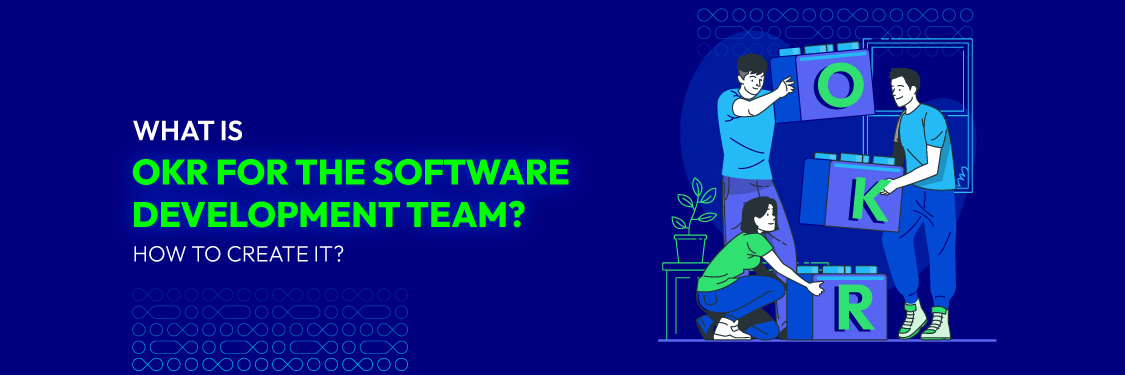15 Best examples of OKR for the software development team
Vinh Jacker | 07-31-2023

Every organization needs a software development team.
This team dramatically contributes to delivering services or products and is vital to the organization’s overall success. They help businesses develop innovative software products, provide high-quality solutions, achieve business objectives, and stay competitive.
However, to optimize the productivity of a software development team, organizations need a measurable method to plan and measure the success of their performance.
This article will provide further information about OKR for the software development team. As a result, organizations and groups can monitor and improve their team performance.
What is OKR for the Software Development Team?
OKR (Objectives and Key Results) is a goal-setting framework that enables organizations and teams to determine and observe their targets and the major outcomes that will indicate progress aligned with those targets.

When applying the OKR model to a software development team, this goal-setting framework will provide teams and organizations with focus, arrangement, and transparency to enhance productivity and attain targeted outcomes.
If an organization wants to express its goals powerfully, then the Objective and Key Results model is a suitable option. It can assist teams, and organizations in crafting a clear mission and vision, aiding in the cooperation of employees and focusing on the company’s top priorities.
5 Key benefits of OKR
In an interview with Harvard Business Review, John Doerr talked about the benefits of OKR, as a helpful method to set and achieve goals. This OKR model has 5 key benefits: focus, alignment, commitment, tracking, and stretching. These “five superpowers” of OKRs spell out “F-A-C-T-S.”
Focus
By setting a clear analysis of objectives, the OKRs model enables businesses to create a priority for their efforts. This model provides a framework used as a tool to identify and focus on primary goals and initiatives.
With clear information, teams and individuals will be more likely to avoid getting overwhelmed with many priorities and focus only on key objectives.
Alignment
OKRs can assist teams in aligning their efforts with the overall goals and objectives of the organization as a whole by coming up with a clear structure. This model creates a set of objectives that is down from the top-level goals, making it easier for everyone to understand how their work contributes to the broader picture.
Commitment
By providing a sense of purpose and direction, the OKRs framework enables every colleague to easily see the targeted goals and understand the great value their work directly contributes to these meaningful objectives.
Hence, this will lead to an increase in motivation and engagement in employees. As all employees acknowledge the impact of their efforts on the organization, they will have a higher commitment to their work, their teams, and the organization as a whole.
Tracking
An ongoing process of tracking OKRs from the beginning to the end is why management by Objectives is so popular and preferable with top-tier companies.
By tracking the objectives and key results via the metrics when they were written, individuals and teams can track their progress and evaluate their performance. This also encourages individuals to be responsible for their goals and results.
Stretching
OKRs foster a culture of striving further to reach out a little more than what they thought was possible. Teams and individuals can set ambitious goals and stretch themselves out of their comfort zones.
This method ensures that valuable insights, innovation, and personal development are still generated even when all key results are not achieved as expected.
Best OKR Examples for Software Development Team
Incorporating Objectives and Key Results (OKRs) into your software development team’s strategy can significantly improve focus, alignment, and performance. Here are 15 OKR examples, each featuring a main objective and specific, measurable key results:
1. Enhance Product Quality
-
Reduce bug count by 30% in the next quarter.
-
Achieve a 95% pass rate on all new feature testing.
-
Decrease customer-reported issues by 40%.
2. Improve Development Efficiency
-
Increase deployment frequency from once a week to three times a week.
-
Reduce lead time for changes by 50%.
-
Implement automated testing to cover 75% of the codebase.
3. Accelerate Feature Delivery
-
Launch 4 new features in the next quarter.
-
Reduce feature development cycle time by 25%.
-
Increase sprint completion rate to 90%.
4. Boost Team Collaboration
-
Achieve a daily standup participation rate of 100%.
-
Implement two cross-functional initiatives per quarter.
-
Increase pull request review speed by 30%.
5. Strengthen Security Measures
-
Pass all security audit checks with no critical vulnerabilities.
-
Conduct 4 security training sessions for the development team.
-
Implement two-factor authentication across all development tools.
6. Increase Customer Satisfaction
-
Achieve a customer satisfaction score of 90%.
-
Reduce average resolution time for customer tickets by 50%.
-
Implement 5 customer-requested features.
7. Optimize Application Performance
-
Improve application load time by 40%.
-
Reduce downtime to less than 0.1% of total time.
-
Increase system scalability to handle a 50% increase in users.
8. Expand Test Coverage
-
Increase unit test coverage to 85%.
-
Implement automated UI tests for 90% of all user flows.
-
Reduce regression test cycle time by 30%.
9. Enhance Development Skills
-
Complete 3 professional development workshops per team member.
-
Achieve certification in a new technology for at least 2 team members.
-
Increase code review efficiency by 25% through training.
10. Improve Code Quality
-
Reduce code complexity scores by 20% across all major modules.
-
Increase use of design patterns in projects by 30%.
-
Achieve 0 critical issues in static code analysis reports.
11. Streamline Project Management
-
Reduce project planning time by 25%.
-
Implement a new project management tool with 100% team adoption.
-
Achieve 95% accuracy in project effort estimation.
12. Foster Innovation
-
Dedicate 10% of development time to innovation projects.
-
Submit 5 proposals for new product features or improvements.
-
Successfully prototype 2 new technologies.
13. Reduce Technical Debt
-
Decrease technical debt by 30% as measured by code analysis tools.
-
Refactor 2 legacy systems to modern frameworks.
-
Document and create mitigation plans for all major legacy issues.
14. Enhance Remote Work Efficiency
-
Implement 2 new tools to improve remote collaboration.
-
Achieve an average task completion rate of 90% for remote sprints.
-
Conduct 2 team-building activities to strengthen remote team dynamics.
15. Increase DevOps Maturity
-
Implement continuous integration/continuous deployment (CI/CD) pipelines for 3 projects.
-
Achieve deployment success rate of 95%.
-
Automate infrastructure provisioning, achieving a setup time reduction of 50%.
These OKR templates offer specific, measurable goals designed to drive significant improvements across various aspects of software development, from product quality and efficiency to security and team collaboration. Tailoring these examples to your team’s unique context and challenges will help set a clear direction and foster a culture of achievement and continuous improvement.
How to Write OKRs for the Software Development Team?
A great framework of OKRs for the software development team must be a framework that is ambitious yet realistic, and they should be collaboratively created with all the team members to ensure commitment and buy-in.
Additionally, when writing OKRs for a software development team, it’s essential to ensure that the objects and key results are aligned with the organization’s goals and objectives concerning the specific needs and challenges of the team.
The analysis of the following example below will provide you with more informed information and a complete understanding of how the OKRs framework is written.
Objective: Improve the Quality and Stability of the Software Product
-
Key Result 1: Reduce the number of critical bugs users report by 50% within the next quarter.
-
Key Result 2: Achieve a code coverage of at least 80% for all critical functionality by the end of the year.
-
Result 3: Decrease the average time to fix high-priority bugs from 3 days to 1 day within the next release cycle.
As written above, the formula for writing OKRs is very simple. Objectives represent goals and intentions, while key results are specific and measurable milestones aligned with those goals and intentions, within a defined timeframe.
The example above has three key results and one objective, the maximum number of results that organizations should have is five, while the number of objectives should never be more than three. Organizations and teams can define objectives and key results by utilizing SMART criteria and considering its five components: Specific, Measurable, Achievable, Relevant, and Time-Bound.
How to Track OKRs For the Software Development Team?
Tracking Objectives and Key Results (OKRs) for a software development team is a strategic approach to ensure alignment with organizational goals and foster continuous improvement. Here’s how to effectively track OKRs in your software development team:
-
Set Clear Objectives: Define specific, measurable objectives aligned with company goals.
-
Identify Key Results: Establish 2-5 measurable key results per objective, relevant to software development metrics.
-
Use OKR Tools: Implement tools like Ally.io or Perdoo for tracking progress and facilitating updates.
-
Regular Reviews: Conduct weekly or bi-weekly check-ins to assess progress on key results.
-
Align OKRs: Ensure team OKRs align with individual contributions and overall organizational goals.
-
Celebrate and Learn: Acknowledge achievements and conduct retrospectives on unmet objectives to identify improvements.
-
Be Flexible: Adjust OKRs based on ongoing feedback and changes in the business landscape.
-
Promote Transparency: Share OKR progress with the entire organization to enhance transparency and collaboration.
Wrap up
Setting an OKRs framework is significantly important for businesses if they want to have a measurable method to help them set ambitious goals and drive progress toward them.
A great OKRs framework, undeniably, will encourage each team member to clearly understand the big goals of organizations and put their effort toward it.





![Top 20+ Must-have Shopify Apps for 2025 [Free & Paid] - Mageplaza](https://cdn2.mageplaza.com/media/blog/must-have-shopify-apps/top-must-have-shopify-apps.png)
![[2025 Updates] Top 10+ Upsell Apps for Shopify - Mageplaza](https://cdn2.mageplaza.com/media/blog/best-upsell-shopify-app/cover.png)